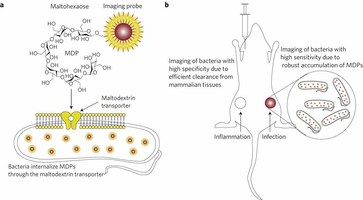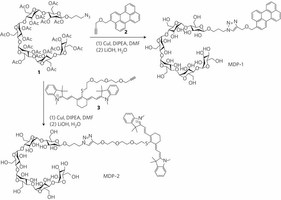研究人员在7月在线出版的《自然—材料学》期刊上报告,一种高敏感造影剂能在小鼠体内成像细菌感染过程。新成果可辅助细菌感染的早期临床诊断,从而帮助人们避免出现严重的医学综合征,如组织损伤或败血症。
在世界范围内,细菌是导致多种疾病和部分死亡的重要原因。成像细菌感染过程的一个主要挑战是如何开发出能快速地、选择性地进入细菌的造影剂。Niren Murthy和同事实现了这一目标,他们用化学方法将一种荧光侧基团链接到一种在许多细菌的新陈代谢中发挥重要作用的特别糖类上,这种侧基团是能产生对比成像的分子的一部分。他们发现,大肠杆菌和其他细菌能迅速吸纳这些代谢成像探针,与过去的造影剂相比,新造影剂能以100倍清晰度敏感成像细菌感染过程。

Nature Materials:新型造影剂可成像细菌感染过程
生物探索推荐英文论文摘要:
Maltodextrin-based imaging probes detect bacteria in vivo with high sensitivity and specificity
The diagnosis of bacterial infections remains a major challenge in medicine. Although numerous contrast agents have been developed to image bacteria, their clinical impact has been minimal because they are unable to detect small numbers of bacteria in vivo, and cannot distinguish infections from other pathologies such as cancer and inflammation. Here, we present a family of contrast agents, termed maltodextrin-based imaging probes (MDPs), which can detect bacteria in vivo with a sensitivity two orders of magnitude higher than previously reported, and can detect bacteria using a bacteria-specific mechanism that is independent of host response and secondary pathologies. MDPs are composed of a fluorescent dye conjugated to maltohexaose, and are rapidly internalized through the bacteria-specific maltodextrin transport pathway, endowing the MDPs with a unique combination of high sensitivity and specificity for bacteria. Here, we show that MDPs selectively accumulate within bacteria at millimolar concentrations, and are a thousand-fold more specific for bacteria than mammalian cells. Furthermore, we demonstrate that MDPs can image as few as 105 colony-forming units in vivo and can discriminate between active bacteria and inflammation induced by either lipopolysaccharides or metabolically inactive bacteria.

Figure 1: In vivo detection of bacteria with MDPs.

Figure 2: Synthesis of MDP-1 and MDP-2.







